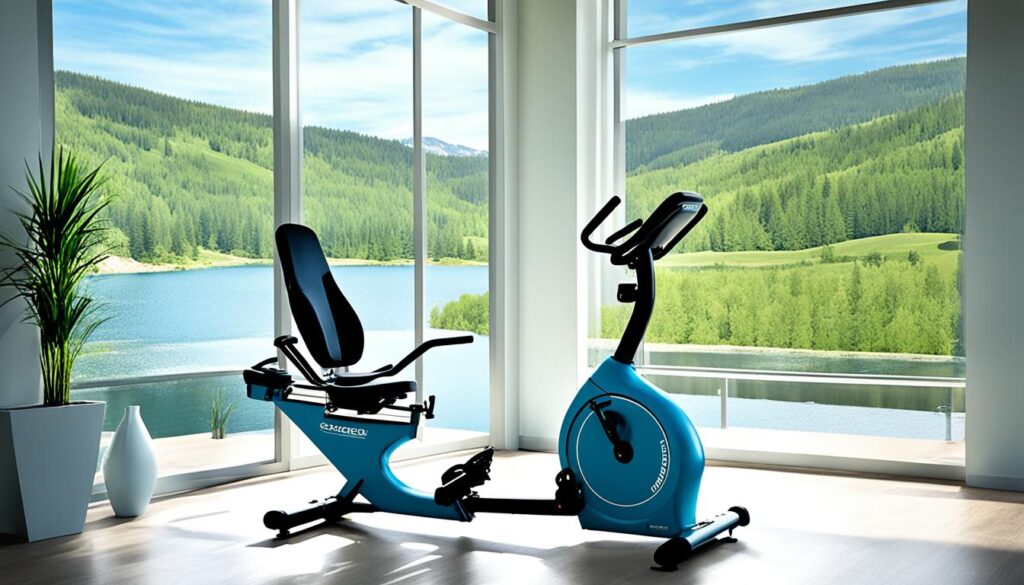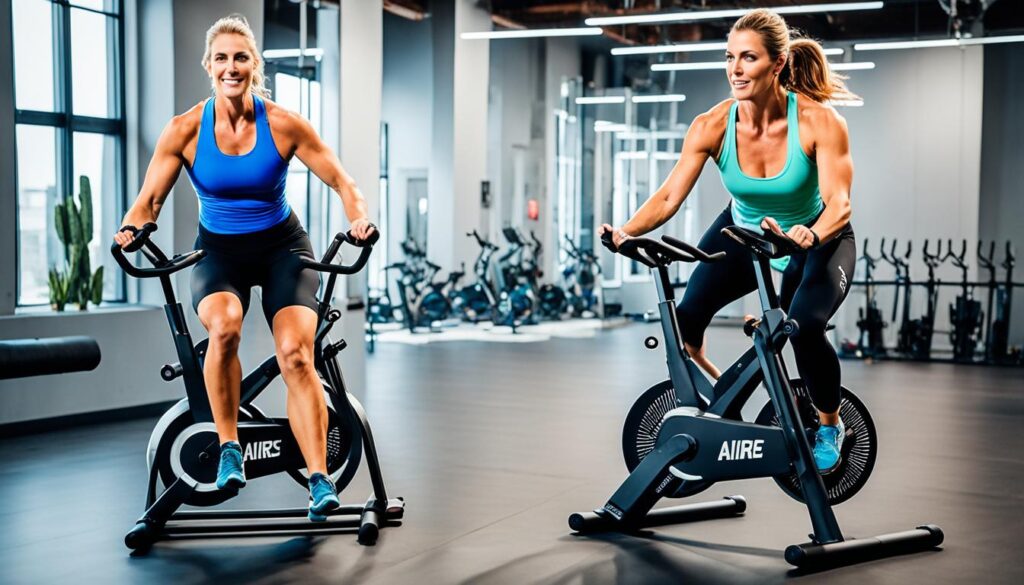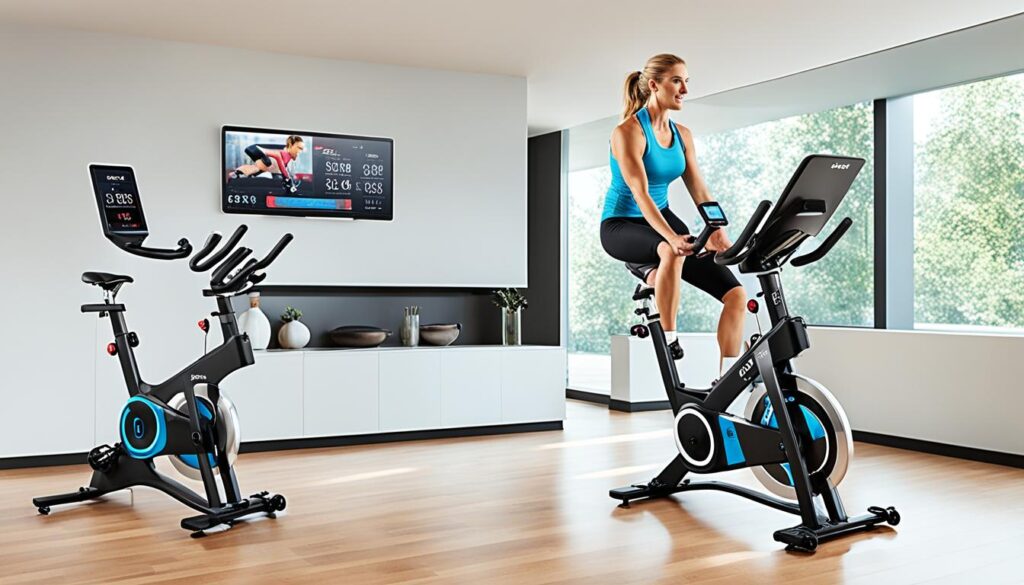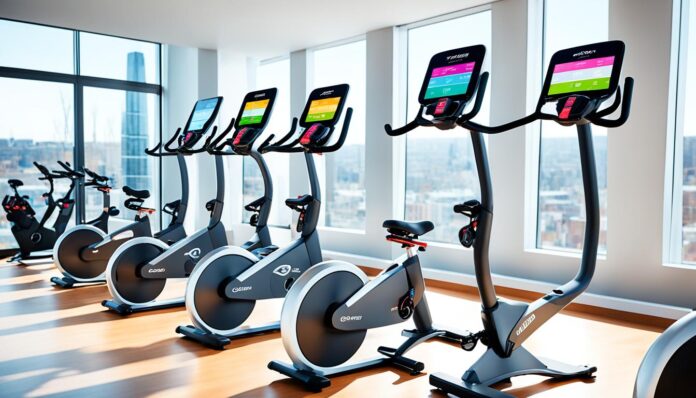When it comes to improving cardiovascular health and building lower body strength, exercise bikes have become a popular choice for home workouts. But with so many different types of exercise bikes on the market, how do you know which one is the best fit for your needs? From spin-style indoor cycles to recumbent bikes and air bikes, each option offers unique features and benefits that cater to different fitness goals, budgets, and space constraints. The question is, which exercise bike will help you achieve your fitness objectives while seamlessly integrating into your home?
Key Takeaways
- Exercise bikes come in a variety of styles, including spin-style indoor cycles, upright bikes, recumbent bikes, and air bikes, each with their own unique features and benefits.
- Indoor cycling bikes range in price from a few hundred dollars to thousands, with higher-end models offering additional features like dumbbells, touchscreens, and interactive programming1.
- Recumbent bikes are ideal for low-impact workouts, particularly for those recovering from injury or with mobility issues1.
- Upright bikes are compact and suitable for high-intensity workouts, while air bikes engage the upper body and provide a full-body workout1.
- Folding exercise bikes offer a space-saving option but may not be suitable for intense training sessions1.
Types of Exercise Bikes: An Overview
When it comes to exercise bikes, there are several distinct types that cater to different fitness needs and preferences. From the intense, high-energy spin bikes to the low-impact and supportive recumbent bikes, the world of exercise bikes offers a diverse range of options for users2.
Spin-Style Indoor Cycles
Spin bikes, also known as indoor cycling bikes, are designed to provide an immersive, studio-style workout experience. With their forward-leaning design and weighted flywheels, spin bikes offer an intense, high-intensity workout that simulates the experience of an indoor cycling class2. These bikes are popular among fitness enthusiasts seeking a challenging, cardiovascular-focused workout2.
Upright Bikes
Upright exercise bikes offer a more traditional, upright riding position, providing a comfortable and familiar cycling experience. These bikes are often more accessible and beginner-friendly, making them a great choice for those new to exercise bikes or looking for a less-intense workout2. Upright bikes typically have a smaller footprint and lower weight compared to other exercise bike types, making them a versatile option for home gyms2.
Recumbent Bikes
Recumbent bikes are designed with a reclined, laid-back seating position, which reduces stress on the joints and lower back. This makes them an excellent choice for individuals seeking a low-impact exercise option or those with mobility or joint issues2. Recumbent bikes are also known for their larger, more supportive seats, providing a comfortable and ergonomic riding experience2.
Dual-Action Air Bikes
Dual-action or “air” bikes are a unique type of exercise bike that engage both the upper and lower body. These bikes feature moving handlebars that work in tandem with the pedaling motion, creating a total-body workout that can be highly effective for high-intensity interval training (HIIT) and calorie-burning2. The resistance on air bikes is generated by a fan, which increases as the user pedals and moves the handlebars faster2.
Bike Trainers for Outdoor Bikes
Bike trainers, also known as indoor bike stands, allow you to transform your outdoor bicycle into a stationary exercise machine. These devices clamp onto the rear wheel of your bike, creating a stable platform for indoor cycling workouts2. Bike trainers are a great option for cyclists who want to maintain their training regimen during inclement weather or off-season periods2.
Whether you’re looking for an intense, high-energy workout or a low-impact, supportive exercise experience, the world of exercise bikes has something to offer for every fitness level and preference2. By understanding the key features and characteristics of each type, you can make an informed decision on which exercise bike is the best fit for your unique needs and goals2.
| Type of Exercise Bike | Typical Weight Capacity | Typical Bike Weight | Typical Cost |
|---|---|---|---|
| Cycling Bikes | 250-300 lbs. | 115-150 lbs. | $300-$1200+ |
| Recumbent Bikes | 250-350 lbs. | 80-150 lbs. | Under $600 |
| Smart or Studio Bikes | 250-300 lbs. | 100-125 lbs. | $500-$1200+ |
| Upright Bikes | 225-300 lbs. | 40-75 lbs. | $150-$650 |
| Dual Action Bikes | 250-350 lbs. | 60-140 lbs. | Under $400 |
| Mini Bikes | N/A | 8-25 lbs. | Under $100 |
| Foldable Bikes | 250 lbs. | 30-60 lbs. | Under $200 |
The home exercise bike market is expected to grow by 8.7% between 2021 and 2027, indicating a rising demand for these versatile fitness solutions3. With a wide range of options available, from spin-style indoor cycles to recumbent bikes and dual-action air bikes, there’s an exercise bike to suit every fitness level and preference2.
Comparing Different Types of Exercise Bikes: Which One is Right for You?
When selecting an exercise bike, it’s crucial to consider your specific fitness goals, budget, and available space4. Each type of exercise bike offers unique features and benefits that may be better suited for different needs. For instance, if you’re seeking a high-intensity, full-body workout, an air bike like the Assault Airbike, which has a 4.7-star rating from over 2,000 users4, may be the optimal choice. On the other hand, if you prioritize a more comfortable, low-impact ride, a recumbent bike from Schwinn’s popular series, with an average rating of 4.5 stars from over 9,000 Amazon reviewers4, could be the better option.
Factors such as resistance mechanisms, adjustability, workout data tracking, and smart technology capabilities will also influence which exercise bike is the right fit for you. For example, the Peloton and Echelon connected exercise bikes can range from about $1,000 to over $2,000, with monthly membership fees of $44 and $35, respectively4. In contrast, the Schwinn 130 upright bike, which received an average rating of 4.4 stars from nearly 5,000 Amazon reviewers4, may be a more budget-friendly option for those seeking a traditional stationary bike.
When considering the type of resistance, magnetic resistance bikes like the Schwinn IC45 tend to be quieter in operation compared to friction-based bikes like the Schwinn IC35. Additionally, direct-drive trainers like the one from Wahoo Fitness can connect to devices to control resistance and support multiple Bluetooth connections4, making them a versatile choice for those seeking advanced technology integration.
Ultimately, understanding the pros and cons of each bike type can help you make an informed decision and find the perfect exercise bike to support your fitness journey. Whether your goal is cardiovascular fitness, strength training, or low-impact exercise, there’s an exercise bike that can cater to your unique needs.
“Recumbent bikes are generally considered gentler on all joints compared to upright bikes, making them a preferred choice for individuals with joint pain.”6
Similarly, upright bikes like the Schwinn IC3 and IC45 offer a more comprehensive workout by engaging abdominal and arm muscles in addition to leg muscles, providing a total body exercise session6. However, recumbent bikes may be better suited for seniors or those who prefer not to engage their core muscles during exercise, while upright bikes are more suitable for individuals focused on overall fitness results6.
When it comes to space constraints, recumbent bikes tend to take up more space than upright bikes6, so this factor should be considered when choosing the right exercise bike for your home gym. High-end bike trainers can cost up to $1,0004, making them a good option for those with limited space who want to transform their outdoor bike into a stationary indoor cycling experience.
By carefully considering your fitness goals, budget, and available space, you can find the perfect exercise bike that will support your health and wellness journey. Whether you choose a spin-style indoor cycle, a recumbent bike, or an air bike, the right exercise bike can help you achieve your fitness goals while providing a comfortable and enjoyable workout experience465.
Indoor Cycling Bikes for High-Intensity Workouts
For those seeking a challenging, calorie-burning exercise experience, indoor cycling bikes are a popular choice. These specialized stationary bikes, often referred to as “spin bikes,” are designed to provide an intense, high-energy workout akin to an indoor cycling studio class. With their forward-leaning body position, weighted flywheels, and reinforced pedals, indoor cycling bikes allow you to stand up and pedal with significant resistance, pushing your muscles and cardiovascular system to their limits.
Features of Indoor Cycling Bikes
The key features that distinguish indoor cycling bikes from other exercise bikes include an exposed flywheel, adjustable resistance via a knob or digital controls, and pedals that can accommodate cycling shoes with clips. This combination of design elements creates a realistic, road-like cycling experience that simulates the demands of outdoor cycling, but within the convenience of your home7.
Pros and Cons of Indoor Cycling Bikes
The benefits of incorporating indoor cycling bikes into your fitness routine are numerous. These bikes offer a challenging, high-intensity workout that can help you burn a significant number of calories and improve your cardiovascular fitness. Additionally, the ability to mimic outdoor cycling allows you to train for real-world cycling events or simply enjoy the sensation of riding a bike without the need for outdoor conditions. However, the narrow seat and forward-leaning position can be uncomfortable for extended periods, and poor technique may lead to back pain for some users8.
When selecting an indoor cycling bike, it’s essential to consider factors such as the flywheel weight, resistance levels, and weight capacity to ensure it aligns with your fitness goals and physical capabilities. Top-of-the-line models like the Peloton indoor training bike feature a 22-inch high-definition touchscreen, allowing you to access a wide range of guided workout classes and track your performance data in real-time7.
Whether you’re training for a cycling event, seeking a challenging cardio workout, or simply aiming to improve your overall fitness, an indoor cycling bike can be a valuable addition to your home gym setup. By understanding the features and benefits of these specialized exercise bikes, you can make an informed decision that supports your fitness journey and helps you achieve your goals789.
Recumbent Bikes for Low-Impact Exercise
For those seeking a gentle, low-impact workout, recumbent exercise bikes offer a highly comfortable and supportive option. Recumbent bikes feature a reclined seating position with the pedals positioned out in front of the rider, creating a more ergonomic and joint-friendly cycling experience1. The recumbent design places the rider closer to the ground, reducing stress on the knees, hips, and lower back1. This makes recumbent bikes an excellent choice for older adults, individuals recovering from injury, or those with joint or mobility concerns.
Benefits of Recumbent Bike Design
The key advantages of the recumbent bike design include improved posture, greater back support, and a more relaxed, low-impact workout. Recumbent bikes typically have a contoured, heavily padded seat that provides enhanced lumbar support, reducing strain on the spine1. The reclined position also helps to take pressure off the joints, making it easier for users with arthritis, joint pain, or limited mobility to exercise comfortably1. Additionally, recumbent bikes often feature a higher weight capacity, accommodating a wider range of users10. This inclusive design makes recumbent bikes an excellent option for seniors or those requiring extra support.
While recumbent bikes may not deliver the same high-intensity workout as other exercise bike types, they excel at providing a low-impact, full-body cardio routine that’s gentle on the joints1. By prioritizing comfort and support, recumbent bikes make exercise accessible to a broader audience, helping individuals of all fitness levels maintain an active and healthy lifestyle.

Recumbent exercise bikes are a game-changer for those seeking a comfortable, low-impact way to improve their cardiovascular health and strength. With features like enhanced back support, reduced joint stress, and accommodating weight capacities, recumbent bikes offer an inviting and inclusive workout experience for users of all ages and abilities10111.
Upright Bikes: The Classic Stationary Bike
For those seeking the classic stationary bike experience, upright bikes offer a familiar and versatile option. Unlike the intense, racing-inspired spin bikes, upright stationary bikes closely resemble traditional outdoor bicycles, with the rider positioned in an upright, vertical stance12.
Upright bikes typically have a more compact design compared to indoor cycling models, with handlebars positioned closer to the rider’s body. The seat on an upright bike is also wider and more padded than the slim saddles found on spin bikes, providing a more comfortable seating position12.
While upright bikes may not offer the same high-intensity workout as indoor cycling models, they do allow for effective cardio workouts and can be suitable for longer exercise sessions due to their more comfortable seating position. Upright upright bikes often feature built-in workout programs and digital displays to track metrics like time, distance, and calories burned12.
One of the key advantages of upright bikes is their versatility. Many models allow users to switch between sitting and standing positions, enabling a more dynamic and engaging workout. This versatility can be particularly beneficial for individuals seeking a well-rounded exercise experience that targets different muscle groups and simulates outdoor cycling13.
When it comes to cost, upright bikes tend to be less expensive than their recumbent counterparts. Additionally, upright bikes often take up less space and many models can be folded for convenient storage, making them an attractive option for those with limited home gym space12.
In summary, upright bikes offer a classic stationary bike experience with a comfortable, versatile design. Whether you’re looking to incorporate low-impact cardio workouts into your routine or simply enjoy the familiar feel of a traditional bicycle, upright stationary bikes are a excellent choice for your home gym121413.
Air Bikes for Full-Body HIIT Training
If you’re seeking a challenging, full-body workout that can help you burn a significant number of calories in a short amount of time, air bikes may be the perfect exercise equipment for you. Also known as dual-action bikes, air bikes engage both your upper and lower body, providing a high-intensity interval training (HIIT) experience unlike traditional stationary bikes15.
Air bikes feature a large fan wheel at the front that creates resistance as you pedal, with moving handlebars that allow you to push and pull in sync with your leg movements. The air resistance generated by the fan wheel increases the harder you pedal, making air bikes an ideal choice for HIIT workouts and cross-training sessions15.
Intense Air Bike Workouts
Unlike spin bikes, which are primarily focused on lower-body training, air bikes offer a full-body workout that engages your arms, shoulders, chest, back, legs, and core16. This makes them a popular choice among CrossFit enthusiasts and HIIT-focused fitness enthusiasts who are looking to maximize their calorie burn and build overall strength and endurance17.
Air bikes are designed to provide an intense, high-intensity workout that can be tailored to your fitness level and goals. By adjusting your pedaling speed, you can increase or decrease the air resistance, allowing you to push yourself to your limits and achieve a challenging, total-body workout in a short period of time1516.
Popular air bike models, such as the Assault AirBike, are frequently used in CrossFit gyms and other HIIT-focused fitness facilities17. These bikes offer a unique and engaging workout experience that can help you improve your cardiovascular fitness, boost your strength, and burn a significant number of calories1516.

Whether you’re a seasoned athlete or just starting your fitness journey, incorporating air bikes into your workout routine can be a highly effective way to challenge your body and achieve your fitness goals. With their ability to provide a full-body, high-intensity workout, air bikes are a versatile and powerful tool for anyone looking to take their training to the next level151617.
“Air bikes are a game-changer for HIIT workouts, offering an intense, full-body challenge that can help you push your limits and see real results.”
Folding Exercise Bikes for Space-Saving Convenience
For fitness enthusiasts living in small spaces, folding exercise bikes offer a practical solution that combines an effective workout with compact, space-saving design18. These bikes are engineered to be easily stored and transported, with a foldable frame that can be tucked away when not in use. While they may not boast the same high-performance features as their full-size counterparts, folding exercise bikes provide a convenient way to stay active without sacrificing precious floor space in your home or apartment.
One of the key advantages of folding exercise bikes is their portability. Models like the Marcy Foldable Upright Bike, which weighs just 39.5 pounds18, can be easily moved and stored, making them an ideal choice for small living spaces or apartments. Additionally, the Lanos 2-in-1 Folding Exercise Bike, weighing 45 pounds18, and the FB150 Folding Exercise Bike, weighing 32 pounds18, offer similar levels of compactness and mobility.
While folding exercise bikes may not boast the same advanced features as their full-size counterparts, they still provide an effective cardio workout. Models like the BulbHead Slim Cycle Folding Stationary Bike, which has a maximum weight capacity of 300 pounds18, and the Exerpeutic 400XL Folding Recumbent Exercise Bike, with a 300-pound weight capacity18, demonstrate that these compact machines can accommodate a wide range of users.
When it comes to folding exercise bikes, versatility and space-saving design are the key priorities. The ProForm Desk Exercise Bike, for instance, combines a folding frame with a built-in desk, allowing users to multitask and work while they pedal18. This innovative design caters to those seeking to integrate fitness into their daily routine without sacrificing productivity.
Overall, folding exercise bikes offer a compelling solution for fitness enthusiasts with limited space, providing a space-saving, portable, and practical way to stay active and maintain a healthy lifestyle1920.
Whether you’re looking for a budget-friendly option like the Pooboo Folding Exercise Bike20 or a more feature-rich model such as the LEIKE X Bike Ultra-Quiet Folding Exercise Bike20, the wide range of folding exercise bikes available on the market caters to diverse fitness needs and space constraints1920.
“Folding exercise bikes offer a convenient and space-saving solution for fitness enthusiasts who live in small spaces, allowing them to stay active without sacrificing precious floor space.”
Understanding Exercise Bike Resistance Systems
When selecting an exercise bike, it’s essential to understand the different types of resistance systems available. Exercise bikes utilize various resistance mechanisms to provide a challenging and customizable workout experience. Let’s explore the key resistance systems and their unique characteristics:
Friction Resistance
Friction resistance is a common and affordable option found on many basic exercise bikes. This system creates resistance by using a felt or rubber pad that presses against the flywheel, providing a consistent and adjustable level of resistance21. While friction resistance bikes offer a strong workout, the felt or leather pads may require periodic replacement due to wear and tear over time22.
Magnetic Resistance
Magnetic resistance exercise bikes use electromagnetic fields to create resistance, providing a smoother, quieter, and more adjustable experience21. These bikes are known for their strong resistance and flexibility in adjusting resistance levels, making them suitable for users seeking a challenging workout21. Additionally, magnetic resistance systems require minimal maintenance, as there is no contact between the magnets and the flywheel21.
Air Resistance
Air resistance bikes, such as the Assault AirBike, utilize a large fan wheel to generate resistance that increases the harder you pedal21. These bikes are preferred for high-intensity interval training (HIIT) and Tabata workouts, as the resistance grows proportionally to your effort21. While not as quiet as magnetic or friction resistance bikes, air bikes produce a noise level comparable to a regular household fan, making them suitable for users who prefer a full-body workout with upper body movements21.
Each resistance system has its own unique benefits and trade-offs in terms of noise, feel, and overall workout experience. Understanding the differences can help you choose an exercise bike with the resistance type that best fits your preferences and fitness goals212223.
Key Features to Consider When Buying an Exercise Bike
When selecting an exercise bike, there are several key features to consider beyond just the resistance system. The saddle or seat is a crucial component that can significantly impact comfort and workout enjoyment, especially for longer sessions. Look for bikes with adjustable, well-padded seats that accommodate your body type. Adjustability in other areas, such as the handlebars, seat height, and pedal position, allows you to find the perfect fit for your body and riding style.
For those who want to closely monitor their workouts, features like built-in digital displays, connectivity to fitness apps, and integration with smart technology can provide valuable workout data and a more immersive exercise experience24. PCMag has tested and rated 16 products in the health & fitness category in the past year, highlighting the importance of these key features when selecting an exercise bike.
Saddle Comfort
The saddle or seat of an exercise bike is a crucial factor in determining the comfort and overall enjoyment of your workout. Look for bikes with adjustable, well-padded seats that can accommodate your body type and riding preferences. This will ensure a comfortable and supportive ride, even during extended cycling sessions.
Adjustability
Adjustability is another essential feature to consider when choosing an exercise bike. The ability to customize the handlebars, seat height, and pedal position allows you to find the perfect fit for your body and riding style. This ensures proper ergonomics and can help prevent discomfort or strain during your workouts.
Workout Data and Connectivity
For fitness enthusiasts who want to closely monitor their progress, exercise bikes with built-in digital displays, connectivity to fitness apps, and integration with smart technology can provide valuable workout data and a more immersive exercise experience24. Features like these can help you track metrics such as distance, speed, resistance, and calories burned, allowing you to set goals and measure your improvement over time.
When it comes to selecting the right exercise bike for your needs, carefully considering these key features can help you find a model that delivers a comfortable, effective, and enjoyable workout experience242526.
Smart vs. Non-Smart Exercise Bikes
When selecting an exercise bike, one key decision is whether to choose a “smart” or “non-smart” model. Smart exercise bikes, such as the Wattbike Atom27, feature advanced technology that can elevate your workout experience. These bikes typically offer built-in displays that grant access to interactive workout classes, real-time performance tracking, and seamless connectivity to fitness apps and smart home devices27.
The benefits of smart exercise bikes lie in their ability to provide a more immersive and motivating workout. With features like virtual training sessions, the ability to compete in races, and the option to connect with personal trainers, smart bikes can help you push the limits of your fitness27. Additionally, these bikes allow users to track and analyze their progress over time, offering valuable insights to help you achieve your fitness goals27.
However, the advanced capabilities of smart exercise bikes often come with a higher price tag. Moreover, accessing the full suite of features may require a monthly subscription, adding to the ongoing cost27.
In contrast, non-smart exercise bikes offer a more basic workout experience but can be a more affordable option for those who don’t require the extensive technological features. These bikes may lack the interactive elements and connectivity of their smart counterparts, but they can still provide an effective and enjoyable workout experience28.
Ultimately, the choice between a smart or non-smart exercise bike will depend on your individual needs, budget, and preferences. Smart bikes offer a more immersive and data-driven workout, while non-smart models provide a more straightforward and potentially more cost-effective solution2728.
| Feature | Smart Exercise Bikes | Non-Smart Exercise Bikes |
|---|---|---|
| Workout Experience | Interactive, immersive workouts with access to virtual training and connectivity to fitness apps | Basic workout experience without advanced technological features |
| Performance Tracking | Comprehensive data tracking and analysis, including metrics like power, heart rate, and calorie burn | Limited or no advanced performance tracking capabilities |
| Cost | Higher initial cost, with potential additional subscription fees to access full suite of features | Generally more affordable, with no ongoing subscription costs |
| Connectivity | Seamless integration with smart home devices and fitness apps for a personalized, connected workout experience | No or limited connectivity options, focusing on the basic exercise bike functionality |

Whether you choose a smart or non-smart exercise bike, both can be effective tools for improving your cardiovascular fitness, building lower body strength, and engaging in low-impact exercise29. The key is to select the option that best fits your budget, fitness goals, and personal preferences2728.
Setting Up the Perfect Home Cycle Studio
Creating a dedicated home gym with the right exercise bike setup can be a game-changer for your fitness routine. By designing a personalized cycling space, you can stay motivated, engaged, and consistent with your workouts30.
Start by evaluating the available space in your home. Choose a clutter-free area that offers ample clearance – at least two feet around the bike for safe and optimal use30. Consider the preferences and fitness goals of other household members who may use the bike as well30.
When selecting your exercise bike, look for models that offer adjustable seats and handlebars to accommodate your size and posture requirements30. Quality bikes, such as those from NordicTrack, Liv Cycling, and featured by Men’s Health, often feature magnetic resistance for a smooth and quiet ride, multiple resistance levels for customized workouts, and interactive touchscreen displays for streaming virtual classes30.
Accessorize your cycling space with key items that can enhance your workout experience. Consider a tablet or smart device holder, a fan to stay cool, and an exercise mat to protect your floor31. If you opt for a smart exercise bike, ensure you have a reliable internet connection and a nearby power outlet31.
Personalize your home cycle studio with motivational decor, storage for water bottles and towels, and perhaps even a small speaker system to create an immersive workout environment31. With the right setup, your exercise bike can become a dedicated fitness oasis, empowering you to achieve your health and wellness goals.
| Exercise Bike Model | Price | Weight Capacity |
|---|---|---|
| Schwinn Fitness AD7 Airdyne Bike | $1,099 – $1,100 | 350 lb. |
| Peloton Bike+ | $125 | 297 lb. |
| AssaultFitness AirBike Classic | $699 | 350 lb. |
| NordicTrack Commercial S22i Studio Cycle | $1,999 | 350 lb. |
“With the right home cycle studio setup, your exercise bike can become a dedicated fitness oasis, empowering you to achieve your health and wellness goals.”
Health Benefits of Regular Cycling
Incorporating regular exercise bike workouts into your fitness routine can provide a variety of health benefits. Cycling, whether on a stationary or outdoor bike, is an effective way to improve cardiovascular fitness and heart health. Studies have shown that vigorous cycling can burn over 500 calories in 4533, with an additional caloric expenditure of about 190 calories on average, 14 hours later33.
Cardiovascular Fitness
Cycling is a excellent cardio exercise that can strengthen the heart and improve overall cardiovascular health. Harvard Medical School reports that bicycling at moderate intensity can burn 210 to 294 calories every 30, with vigorous cycling increasing the burn to 315-441 calories per 30 minutes, depending on the individual’s weight34. Regular cycling can help lower blood pressure, cholesterol, and triglyceride levels, reducing the risk of heart disease and stroke33.
Lower Body Strength
The pedaling motion of cycling primarily engages the lower body muscle groups, such as the quadriceps, hamstrings, and calves, leading to improved leg strength and endurance. Studies have shown that indoor cycling can effectively tone and strengthen these lower body34. Additionally, recumbent bikes focus more on the glutes and lower abdominal muscles, providing a well-rounded lower body workout35.
Low-Impact Exercise
One of the significant advantages of exercise bikes is their low-impact nature, making them a suitable option for individuals looking to improve their fitness while minimizing the risk of injury. A systematic review of over 700 participants found that stationary bike users with osteoarthritis in their knees reported reduced joint pain and improved performance compared to non-exercisers33. This makes exercise bikes an excellent choice for those recovering from an injury or dealing with joint pain, as the low-impact nature of cycling is easier on the joints compared to high-impact activities like running.
FAQ
What are the different types of exercise bikes?
The main types of exercise bikes include spin-style indoor cycles, upright bikes, recumbent bikes, dual-action or “air” bikes, and bike trainers for outdoor bicycles.
How do I choose the right exercise bike for my needs?
When selecting an exercise bike, consider factors such as your fitness goals, budget, available space, and preferred workout style. Different bike types cater to different needs, from high-intensity spin bikes to comfortable recumbent models.
What are the key features of indoor cycling or “spin” bikes?
Indoor cycling bikes feature a forward-leaning body position, weighted flywheels, and reinforced pedals that allow for an intense, high-energy workout experience.
What are the benefits of a recumbent exercise bike?
Recumbent bikes offer a more supportive, low-impact workout with reduced stress on the joints, making them a great choice for older adults or those recovering from injury.
How do air bikes or dual-action bikes differ from other exercise bikes?
Air bikes engage both the upper and lower body, using a large fan wheel to create resistance that increases with your pedaling intensity, making them ideal for high-intensity interval training (HIIT) workouts.
What are the advantages of a folding exercise bike?
Folding exercise bikes provide a convenient, space-saving solution for home workouts, allowing you to easily store the bike when not in use.
What types of resistance systems do exercise bikes use?
Common resistance systems include friction resistance, magnetic resistance, and air resistance, each with their own unique benefits in terms of feel, noise, and adjustability.
What other key features should I look for in an exercise bike?
Important features include a comfortable, adjustable seat, adjustability in other areas like handlebars and pedals, and the availability of digital displays and connectivity to fitness apps.
What are the benefits of a “smart” exercise bike compared to a non-smart model?
Smart exercise bikes offer a more immersive and interactive workout experience, with features like large built-in displays, access to virtual classes, and the ability to track and analyze your performance over time.
How can I create the perfect home setup for my exercise bike?
Consider the available space, add accessories like a tablet holder and fan, and personalize your home cycle studio with motivational decor to enhance your workout experience.
What are the health benefits of using an exercise bike regularly?
Exercise bikes can improve cardiovascular fitness, strengthen lower body muscles, and provide a low-impact form of cardio, making them a suitable option for those looking to improve their fitness while minimizing the risk of injury.
Source Links
- The Different Types of Exercise Bikes | Garage Gym Reviews
- 7 Types of Exercise Bikes to Reach Your Goals | Academy
- What Are the Different Types of Exercise Bikes?
- Here’s everything you need to know before buying an exercise bike
- Best in Class
- Recumbent Bike vs. Upright Bike
- Best exercise bikes and smart indoor bikes for home workouts
- Editor-Tested & Home Studio Ready: The Best Indoor Cycling Bikes for Every Budget
- [Expert-Tested]: The 14 Best Exercise Bikes of Summer 2024 | Garage Gym Reviews
- The 7 Best Recumbent Exercise Bikes in (2024) | Garage Gym Reviews
- The Different Types of Exercise Bikes
- Recumbent Bike vs. Upright Bike – What’s the Difference?
- Exercise Bike vs Spin Bike: The Ultimate Showdown
- An upright bike vs a recumbent bike: which one is right for you? | NordicTrack Blog
- What’s Better for Your Workout: Air Bikes or Spin Bikes?
- Air Bikes Vs. Spin Bikes | Which One Should You Buy?
- Best Air Bike for 2024 | Garage Gym Reviews
- 8 Folding Exercise Bikes for a Space-Saving Cardio Workout
- Fold, Ride, Repeat: Our Favorite Folding Exercise Bikes for Easy Storage
- 7 Best Folding Exercise Bike 2024 | Garage Gym Reviews
- Magnetic Resistance vs. Other Types of Resistance for Cycle Bikes – Wh
- Spin Bike Resistance: What You Need to Know – BODYCRAFT
- Choosing a Spin Bike: Magnetic, Flywheel, or Chain?
- The Best Home Exercise Bikes for 2024
- How to Choose the Best Exercise Bike to Meet Your Fitness Goals
- How To Choose An Exercise Bike | Garage Gym Reviews
- Spin Bike vs Smart Bike: Which is Better for At-Home Training?
- Exercise Bike Types, Benefits & Best Buying Guide
- Indoor trainer vs. stationary bike: Which should you buy?
- The Ultimate Guide to the Best Exercise Bikes of 2024 | NordicTrack Blog
- How to Set Up Your Bike for Indoor Training | Liv Cycling Official site
- 7 Indoor Exercise Bikes You’ll Actually Want to Ride
- The Top 8 Exercise Bike Benefits, According to Research
- Exercise Bike Vs. Walking: Full Guide & Comparison | freebeat
- How to choose the best exercise bike for a cardio workout at home | CAROL Bike



